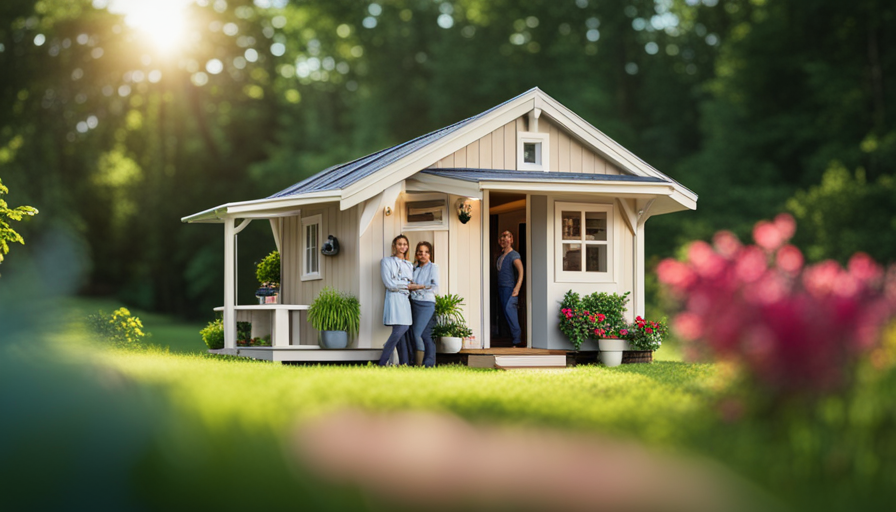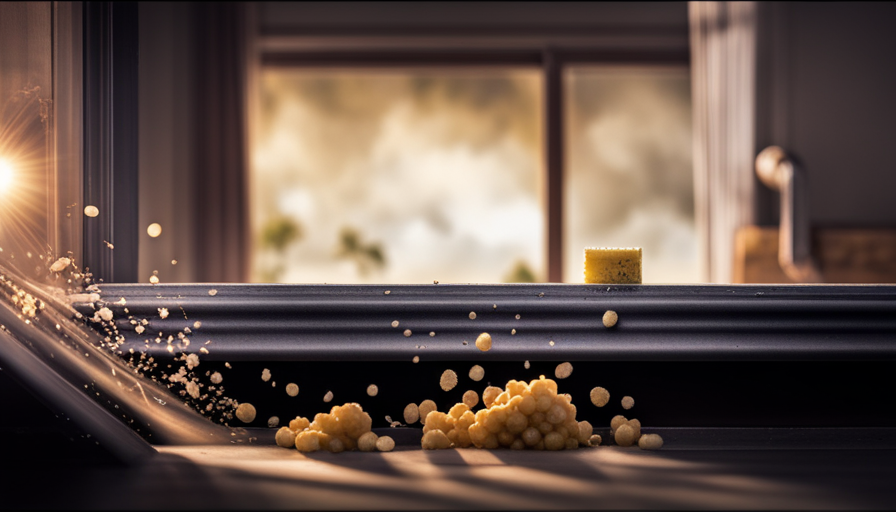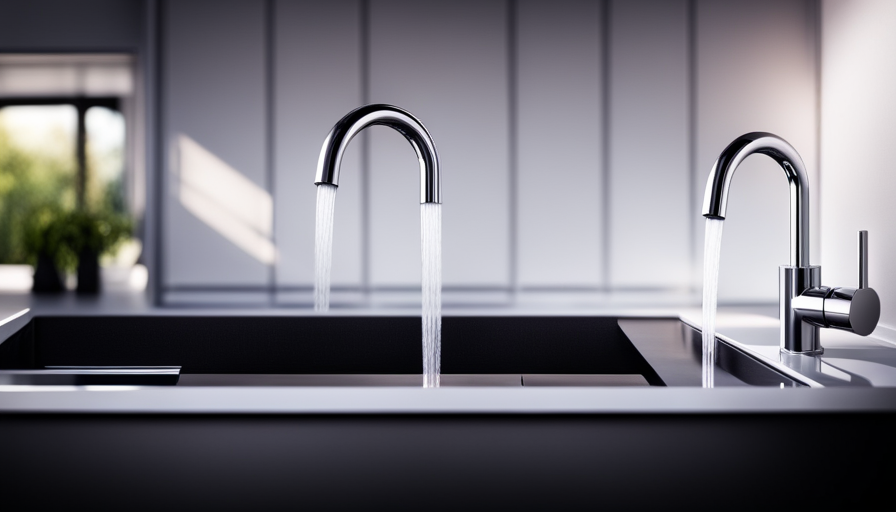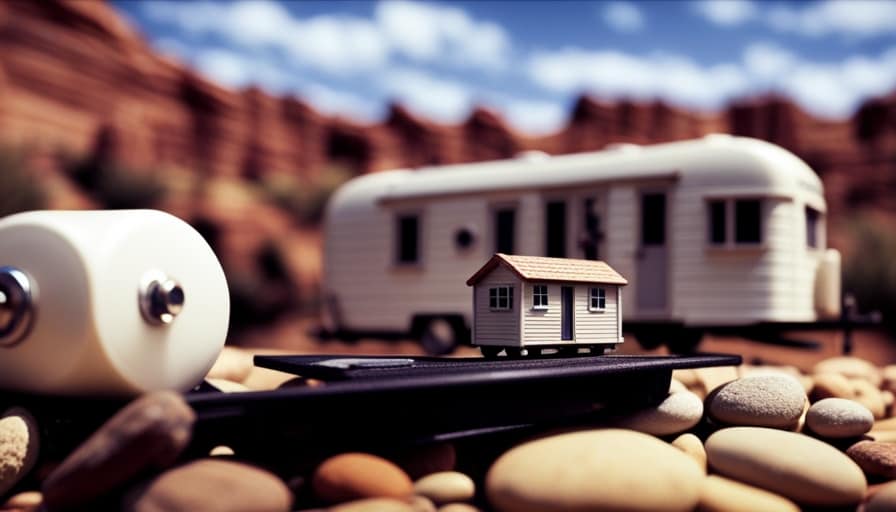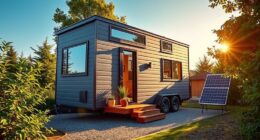Did you know that the average cost for a small home is around $50,000? While this may seem like a significant investment, many people are willing to make this financial commitment in order to experience the freedom and financial benefits that come with tiny home living.
However, financing a tiny house can be a bit different than getting a traditional mortgage for a larger home. In this article, I will guide you through the process of getting a loan for a tiny house, step by step.
From understanding the cost of a tiny house to improving your credit score, researching loan options to negotiating loan terms, I will provide you with all the information you need to secure financing for your tiny dream home.
So, if you’re ready to take the leap into tiny house living, let’s get started on your loan journey.
Key Takeaways
- Research and compare prices from different builders or suppliers for an accurate estimate of the cost of a tiny house.
- Gather financial documents and improve credit score to increase eligibility for obtaining a loan for a tiny house.
- Consider alternative financing options such as personal loans, peer-to-peer lending, and RV loans.
- Shop around for lenders specializing in tiny house financing and compare interest rates and loan terms to find the best option.
Understand the Cost of a Tiny House
Understanding the cost of a tiny house is crucial in order to determine the feasibility of obtaining a loan. Cost estimation plays a significant role in the process of financial planning for a tiny house project. Before seeking a loan, it’s important to have a clear understanding of the expenses involved in building or buying a tiny house.
When it comes to cost estimation, there are several factors to consider. The size and design of the tiny house, as well as the materials used and any additional features, can greatly impact the overall cost. It’s also important to account for any permits or land costs that may be required.
To get a more accurate estimate, it’s helpful to research and compare prices from different builders or suppliers. Additionally, considering the location and whether you plan to build the tiny house yourself or hire professionals can also affect the cost.
Determining your budget and financing needs is the next step in the process. By understanding the cost of a tiny house, you can better evaluate your financial situation and determine how much funding you’ll need. With this information, you can then explore different loan options and find the best solution for your needs.
Determine Your Budget and Financing Needs
To figure out how much you can afford and how you’ll pay for it, start by determining your budget and financing needs when considering a small dwelling. It’s important to know your financial limitations and explore different financing options to make your tiny house dream a reality.
Here are some steps to help you determine your budget and financing needs:
-
Assess Your Income and Expenses: Calculate your monthly income and expenses to understand how much you can allocate towards your tiny house. This will give you a clear idea of what you can afford and how much you need to borrow.
-
Determine Loan Eligibility: Research the eligibility criteria for obtaining a loan for a tiny house. Factors such as credit score, income stability, and debt-to-income ratio are typically taken into consideration. Knowing your eligibility will help you understand the loan amount you can qualify for.
-
Explore Alternative Financing Options: Apart from traditional bank loans, there are other financing options available for tiny house enthusiasts. These include personal loans, peer-to-peer lending, and RV loans. Exploring these alternatives can provide you with more flexibility and potentially better terms.
By determining your budget and exploring alternative financing options, you can make an informed decision on how to finance your tiny house. Once you have a clear understanding of your financial situation, you can move on to researching loan options for tiny houses.
Research Loan Options for Tiny Houses
Once you step into the world of financing your tiny dream, a treasure trove of loan options awaits your exploration. Researching loan options for tiny houses is crucial to finding the best fit for your financial needs. There are several types of loans available, each with their own set of financing requirements. To help you navigate through the various options, I have compiled a table below outlining some popular loan options for tiny houses:
| Loan Option | Financing Requirements |
|---|---|
| Personal Loan | Good credit score, proof of income, collateral may be required |
| RV Loan | Good credit score, proof of income, collateral may be required |
| Construction Loan | Detailed construction plans, good credit score, proof of income |
| FHA Loan | Good credit score, low debt-to-income ratio, proof of income |
These are just a few loan options to consider, and each lender may have additional requirements. It’s important to thoroughly research each option and compare interest rates and repayment terms. Gathering your financial documents is the next step in the process of financing your tiny house. This will include providing proof of income, bank statements, and any other documentation required by the lender.
Gather Your Financial Documents
Now is the time to gather all your financial documents, so you can confidently embark on the journey towards making your tiny house dreams a reality. When it comes to financing your tiny house, there are several alternative options to consider. Traditional mortgages may not be available for tiny houses, but there are specialized lenders who offer loans specifically for this type of housing. Researching and comparing these loan options is crucial to finding the best fit for your unique situation.
Before approaching lenders, it’s important to gather all the necessary financial documents. This includes recent pay stubs, tax returns, bank statements, and any other documentation that shows your income and assets. Lenders will also want to see your credit history, so be prepared to provide your credit report and score.
Exploring the benefits of downsizing can also help in the loan application process. Downsizing not only saves money on housing costs, but it also demonstrates to lenders that you have a responsible financial mindset. By downsizing, you show that you are committed to a simpler lifestyle and are more likely to be able to afford the loan payments.
Now that you have your financial documents in order and have explored the benefits of downsizing, it’s time to take the next step and improve your credit score.
Improve Your Credit Score
Improving your credit score can open doors to better financial opportunities and increase your chances of securing the financing you need for your dream home. Lenders rely heavily on credit scores to assess an individual’s creditworthiness and determine their eligibility for a loan. Therefore, it’s crucial to take steps to improve your creditworthiness before applying for a loan for a tiny house.
One way to improve your credit score is by reviewing your credit report and addressing any errors or discrepancies. You can obtain a free copy of your credit report from each of the three major credit bureaus once a year. Carefully examine the report for inaccuracies and dispute any incorrect information.
Additionally, consider working with credit repair services, which can help you navigate the process and negotiate with creditors on your behalf.
Another effective method to boost your credit score is by paying your bills on time and reducing your overall debt. Timely payments demonstrate responsibility and reliability, which are highly valued by lenders. Moreover, reducing your debt-to-income ratio can significantly improve your creditworthiness.
By improving your credit score, you increase your chances of obtaining favorable loan terms and competitive interest rates for your tiny house. Once you’ve taken the necessary steps to improve your creditworthiness, it’s time to shop around for lenders who specialize in tiny house financing.
Shop Around for Lenders
Exploring various lenders can provide individuals with a wider range of options when it comes to securing financing for their desired compact dwelling. Finding alternative financing is crucial, as traditional banks may not always offer loans specifically tailored for tiny houses. Here are a few things to consider when shopping around for lenders:
-
Online lenders: Many online lenders specialize in alternative financing options, including loans for tiny houses. These lenders often have more flexible requirements and can provide funding faster than traditional banks.
-
Credit unions: Joining a credit union can be beneficial, as they typically offer lower interest rates and more personalized service compared to larger financial institutions. Some credit unions even have specific loan programs for tiny houses.
-
Non-profit organizations: Certain non-profit organizations provide loans specifically for affordable housing, including tiny houses. These organizations may offer lower interest rates and more favorable loan terms.
It’s important to weigh the pros and cons of different loan types. For example, while a personal loan may offer more flexibility, it may also come with higher interest rates compared to a traditional mortgage. Ultimately, it’s essential to find a lender that understands the unique challenges and opportunities of financing a tiny house.
Next, we will delve into how to compare interest rates and loan terms, ensuring you make an informed decision when securing financing for your dream tiny house.
Compare Interest Rates and Loan Terms
Finding the perfect lender for your compact abode involves carefully comparing interest rates and loan terms, ensuring that you secure financing that aligns with your dreams and aspirations. When comparing interest rates, it’s essential to consider both the rate itself and whether it is fixed or variable. Fixed rates provide stability and predictability, while variable rates can fluctuate over time. Additionally, take note of any introductory rates that may expire after a certain period.
To make the process easier, I’ve created a table below that compares interest rates and loan options from different lenders. This table will help you visualize the differences and make an informed decision that suits your financial needs.
| Lender | Interest Rate | Loan Term |
|---|---|---|
| Bank A | 3.5% | 20 years |
| Credit Union B | 3.75% | 15 years |
| Online Lender C | 4.0% | 30 years |
Remember, interest rates are not the only factor to consider. Loan terms also play a crucial role in determining the total cost of your loan. A longer loan term may result in lower monthly payments, but you may end up paying more in interest over time.
Now that you have compared interest rates and loan terms, it’s time to prepare a loan application and take the next step towards turning your tiny house dreams into reality.
Prepare a Loan Application
Before you can embark on your journey to transform your compact abode dreams into reality, it’s time to gather all the necessary documents and information to prepare a loan application that will bring you one step closer to your dream home.
To ensure your loan eligibility, start by organizing your financial documents, such as pay stubs, bank statements, and tax returns. These documents will provide a comprehensive overview of your financial situation and help lenders assess your ability to repay the loan.
Next, gather information about the tiny house you plan to purchase. This includes details on the construction, size, and location of the house, as well as any additional features or modifications you intend to make. Providing a clear and detailed description of the property will help lenders understand the value of the investment.
Complete the loan application form accurately and thoroughly. Double-check all the information before submitting, as any errors or omissions could delay the approval process. Be prepared to provide additional documentation or answer any questions that may arise during the application review.
By following these steps and submitting a comprehensive loan application, you increase your chances of securing the financing needed for your tiny house. Once your application is submitted, you can move on to negotiate loan terms and conditions, bringing you closer to achieving your dream of owning a cozy and sustainable home.
Negotiate Loan Terms and Conditions
When it comes to achieving your dream of owning a cozy and sustainable home, you’re now ready to take the next step: negotiating the terms and conditions of your loan. Negotiating loan terms is crucial as it can significantly impact your overall financial situation.
The first step is to find the right lender who specializes in tiny house loans and understands your unique needs. Look for lenders who offer competitive interest rates, flexible repayment terms, and are willing to finance the specific type of tiny house you want.
Once you have found potential lenders, it’s time to start negotiating. Prepare yourself by researching current interest rates and loan terms in the market. This will give you a baseline for comparison and help you negotiate better terms.
During the negotiation process, be open and honest about your financial situation and your plans for the tiny house. Discuss any concerns or questions you may have and make sure you fully understand the terms and conditions before signing any documents.
As you wrap up the negotiation process, it’s important to transition into the next section about closing the loan and starting to build your tiny house. With the loan terms and conditions in place, you can now move forward confidently with your plans to bring your dream tiny house to life.
Close the Loan and Start Building Your Tiny House
Once you have successfully secured the financing for your dream abode, it is time to proceed with the loan closing process and embark on the exciting journey of constructing your petite sanctuary. The loan closing process involves finalizing all the necessary paperwork and signing the loan agreement. It is crucial to review the terms and conditions thoroughly to ensure that you fully understand your obligations and rights as a borrower.
After the loan is closed, you can start building your tiny house according to your construction timeline. It is essential to have a well-organized plan in place to ensure a smooth and efficient construction process. Consider creating a detailed timeline that outlines each phase of the construction, from site preparation to finishing touches. This will help you stay on track and meet your deadlines.
To give you a visual representation, here is a table outlining a sample construction timeline:
| Phase | Duration | Tasks |
|---|---|---|
| Site Preparation | 2 weeks | Clearing, grading, and leveling the land |
| Foundation | 3 weeks | Pouring concrete and setting up the foundation |
| Framing | 4 weeks | Constructing the walls, roof, and floor structure |
| Plumbing and Wiring | 2 weeks | Installing plumbing and electrical systems |
| Interior Finishing | 4 weeks | Adding insulation, drywall, flooring, and fixtures |
By following a well-defined construction timeline, you can ensure that your tiny house is built efficiently and within the agreed-upon timeframe. Remember to communicate regularly with your contractor and monitor the progress to make any necessary adjustments along the way.
Frequently Asked Questions
Can I use a personal loan to finance my tiny house?
Yes, I can definitely use a personal loan to finance my tiny house. Personal loan options provide a convenient and flexible way to obtain the necessary funds for building or purchasing a tiny house. The benefits of using a personal loan for a tiny house include lower interest rates, quick approval process, and the ability to use the funds for various expenses related to the construction or purchase of the house.
What are the different types of loans available for tiny houses?
There are several types of loans available for tiny houses, each with its own set of requirements and interest rates.
One option is a personal loan, which can be used to finance a tiny house. These loans typically have higher interest rates and may require a good credit score and proof of income.
Another option is a construction loan, specifically designed for building a tiny house. These loans usually have lower interest rates, but may have stricter requirements such as a detailed construction plan and a larger down payment.
Do I need a down payment to get a loan for a tiny house?
Yes, a down payment is typically required when getting a loan for a tiny house. However, there are alternatives to a traditional down payment that you can explore. Some lenders offer options for no down payment or low down payment loans for tiny houses. It’s important to do your research and compare different lenders to find the best option for your specific situation.
Can I get a loan for a tiny house if I have bad credit?
Yes, it’s possible to get a loan for a tiny house even if you have bad credit. While traditional lenders may be hesitant to approve a loan without a good credit history, there are alternative financing options available. Some options include finding a co-signer with good credit, exploring peer-to-peer lending platforms, or seeking out specialized lenders who cater to individuals with poor credit.
It’s important to research and compare these options to find the best fit for your situation.
How long does it typically take to get approved for a loan for a tiny house?
The loan approval process for a tiny house can vary depending on various factors. On average, it takes approximately 2-4 weeks to get approved for a loan.
During this time, the lender will review your credit history, income, and other relevant factors. It’s important to provide all the necessary documentation and information promptly to expedite the process.
Once approved, you can proceed with purchasing your dream tiny house.
Conclusion
In conclusion, obtaining a loan for a tiny house can be a complex process, but with careful planning and research, it’s definitely possible. By understanding the costs involved and determining your budget, you can explore different loan options and secure financing for your dream tiny home.
Remember to gather all necessary financial documents, work on improving your credit score, and compare interest rates and loan terms to find the best option for you. With determination and perseverance, you can successfully close the loan and begin building your own little piece of paradise.
Hi, I’m Emma. I’m the Editor in Chief of Tiny House 43, a blog all about tiny houses. While tree houses are often associated with childhood, they can be the perfect adult retreat. They offer a cozy space to relax and unwind, surrounded by nature. And since they’re typically built on stilts or raised platforms, they offer stunning views that traditional homes simply can’t match. If you’re looking for a unique and romantic getaway, a tree house tiny house might just be the perfect option.
